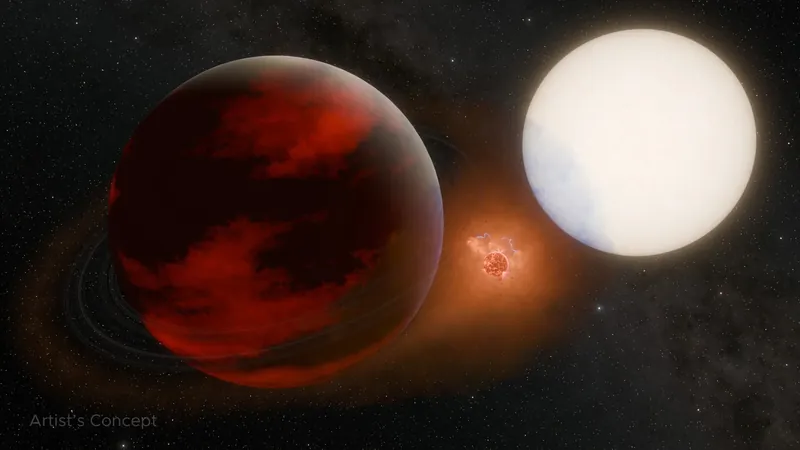
Could We Discover a Volcanic Moon around a Distant Exoplanet Like Jupiter's Io?
2024-10-10
Author: Mei
Introduction
A recent groundbreaking study from NASA’s Jet Propulsion Laboratory has unveiled the exciting possibility of a rocky, volcanic moon orbiting an exoplanet located 635 light-years away from Earth. The evidence comes from an intriguing sodium cloud found in close proximity to a gas giant named WASP-49 b, which is similar in size to Saturn. Although this cloud appears to be slightly misaligned with the planet’s orbit, researchers emphasize that further studies are necessary to understand its origin and behavior.
Challenges in Detection
As of now, no exomoons have been definitively confirmed, but researchers have identified multiple candidates. The difficulty in confirming these celestial companions likely lies in their small size and dim light relative to their host planets, which makes detection challenging with current telescopes.
The Sodium Cloud Discovery
The sodium cloud was first observed in 2017 by Apurva Oza, a former postdoctoral researcher at JPL, who has since been investigating how the volcanic activity of potential exomoons could be detected. Within our own solar system, Jupiter's moon Io acts as a prime example; it releases a vast amount of gases, including sulfur dioxide and sodium, contributing to a massive gas cloud that can extend up to 1,000 times the radius of Jupiter.
Compositions and Sodium Emissions
Both WASP-49 b and its host star are primarily composed of hydrogen and helium, with only trace amounts of sodium. Yet, this sodium cloud appears to be generating a staggering 220,000 pounds (about 100,000 kilograms) of sodium per second, raising questions about its origin—neither the planet nor the star could create that much sodium, and the mechanism for its ejection into space remains uncertain.
Could a Volcanic Exomoon Be Present?
Could this cloud indicate the presence of a volcanic exomoon? Oza and his team endeavored to answer this intriguing question. However, observing the system from such a vast distance posed challenges, as the star, planet, and sodium cloud frequently blended into a single point of light in the night sky. To overcome these hurdles, the research team closely monitored the system over time.
Key Observations
In their recent study published in the Astrophysical Journal Letters, researchers presented compelling evidence suggesting that the sodium cloud is indeed produced by an orbiting body. Key observations revealed that the cloud occasionally swelled in size when it was not situated next to the planet, giving the impression of being replenished. Moreover, the speed of the cloud appeared to surpass that of the planet, which would be inconsistent with it being a part of the planet's atmosphere.
Significance of the Findings
"This is a crucial piece of evidence," Oza commented, "the cloud is moving in a manner contrary to what physics would predict if it were merely a component of the planet's atmosphere." While these findings are exciting, the team acknowledges that prolonged observation is essential to gain clarity on the cloud's orbital characteristics.
Instrumental Validation
Utilizing the European Southern Observatory's Very Large Telescope in Chile, the researchers confirmed that the sodium cloud resides high above the atmosphere of WASP-49 b, akin to the gas clouds produced by Io around Jupiter. Additionally, a computer model developed by the team suggested that the presence of an exomoon with an eight-hour orbit could explain the observed cloud dynamics, supporting the theory of a moon influencing the cloud formation.
Futuristic Implications
"The evidence strongly indicates that there is something beyond just the planet and star contributing to this cloud's existence," noted Rosaly Lopes, a planetary geologist at JPL and co-author of the study. "Detecting an exomoon would be a remarkable achievement, and our knowledge of Io reinforces the idea of a volcanic exomoon being a realistic possibility."
Tidal Volcanism and Fate of the Exomoon
It’s fascinating to consider the implications of such a discovery. On Earth, volcanic activity is fueled by heat from the planet’s core; however, volcanic eruptions on Io are primarily driven by the immense gravitational forces exerted by Jupiter, causing the moon to experience tidal flexing and thus heating its interior—a process known as tidal volcanism. If indeed there is a moon orbiting WASP-49 b that is of a similar size to Earth’s moon, simulations suggest that its continual mass loss combined with the gravitational stresses from the gas giant could ultimately lead to its destruction.
Conclusion
"If this moon does exist, it could face a catastrophic fate," Oza warned, leaving us to ponder the volatile and often transient nature of celestial bodies in the cosmos. The quest for understanding potential exomoons opens a door to a wealth of cosmic mysteries waiting to be explored!

 Brasil (PT)
Brasil (PT)
 Canada (EN)
Canada (EN)
 Chile (ES)
Chile (ES)
 España (ES)
España (ES)
 France (FR)
France (FR)
 Hong Kong (EN)
Hong Kong (EN)
 Italia (IT)
Italia (IT)
 日本 (JA)
日本 (JA)
 Magyarország (HU)
Magyarország (HU)
 Norge (NO)
Norge (NO)
 Polska (PL)
Polska (PL)
 Schweiz (DE)
Schweiz (DE)
 Singapore (EN)
Singapore (EN)
 Sverige (SV)
Sverige (SV)
 Suomi (FI)
Suomi (FI)
 Türkiye (TR)
Türkiye (TR)